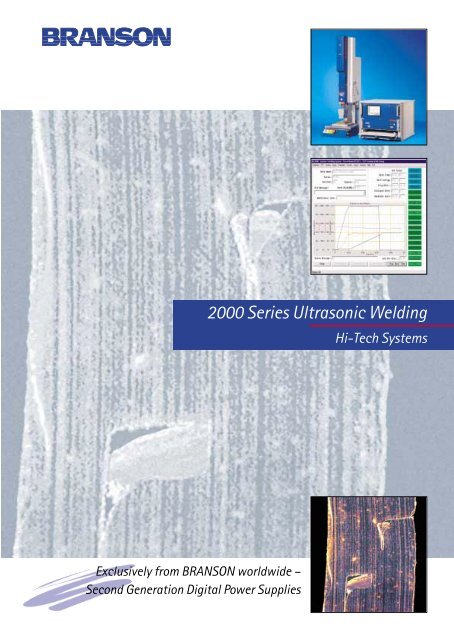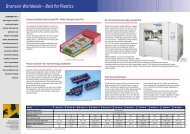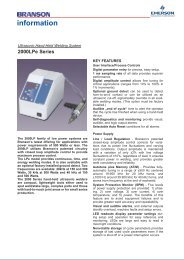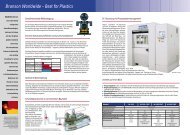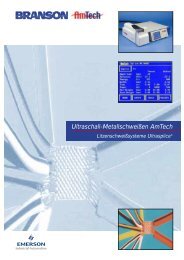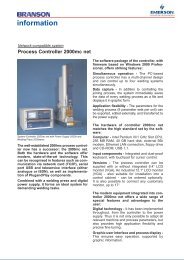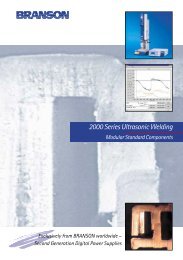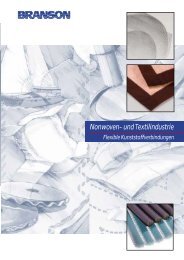2000 Series Ultrasonic Welding - Branson Ultrasonics BV
2000 Series Ultrasonic Welding - Branson Ultrasonics BV
2000 Series Ultrasonic Welding - Branson Ultrasonics BV
You also want an ePaper? Increase the reach of your titles
YUMPU automatically turns print PDFs into web optimized ePapers that Google loves.
<strong>2000</strong> <strong>Series</strong> <strong>Ultrasonic</strong> <strong>Welding</strong><br />
Hi-Tech Systems<br />
Exclusively from BRANSON worldwide –<br />
Second Generation Digital Power Supplies
<strong>Branson</strong> Worldwide – Best for Plastics<br />
BRANSON offers a<br />
wide range of successful<br />
welding techniques,<br />
based on the know-how<br />
gathered in over<br />
50 years on the global<br />
Variable joining velocity leads to higher quality weld seams<br />
The strength of a weld seam has been shown to depend to a high degree on the joining velocity<br />
in relation to the meltdown during the welding process. This relationship determines the melt<br />
flow characteristics and the thickness of the melted region and thus the strength and quality of<br />
the weld seam. This leads to:<br />
greater stability through increased bond layer thickness<br />
improved visual appearance of the welded area<br />
reduced ejection of particles<br />
improved stress resistance, especially in plastics prone to tensional cracks<br />
market. Simultaneously,<br />
international presence is<br />
an important basis for<br />
our special consulting<br />
teams when analysing<br />
problems in key industries.<br />
It goes without<br />
saying that our customers<br />
can depend on our<br />
discretion in finding<br />
solutions.<br />
Innovation:<br />
Closed loop control<br />
of joining velocity<br />
Specific requirements are automatically identified<br />
and taken into account.<br />
This is achieved by the newly developed closed<br />
loop control procedure, whereby a computer is<br />
given a predefined constant velocity, and then<br />
adjusts all other variables accordingly to maintain<br />
it.<br />
In addition to special software, this requires a<br />
welding press with an attached servo drive,<br />
which instantaneously respond to the signals<br />
from the computer.<br />
These innovative procedures from BRANSON<br />
offer unique solutions to problems that would<br />
typically arise when low viscosity plastics such<br />
as PA or POM when welded, swaged or staked.<br />
<strong>2000</strong>mc process controller<br />
Section of a back pressure<br />
valve made of PCU:<br />
The macro photo shows a<br />
pressure-tight step joint<br />
incorporating flash<br />
capturing cavities.<br />
Amplitude and force profiling<br />
Both methods control the joining process<br />
using presets determined by empirical knowledge.<br />
They indirectly ensure optimal welding<br />
conditions, leading to a controlled melting in<br />
the welding zone.<br />
Amplitude profiling (pat.)<br />
The <strong>2000</strong>mc process controller varies the<br />
amplitude of the horn according to certain<br />
reference values (welding time, distance,<br />
energy, power level), consequently reducing<br />
the required plastification energy during the<br />
residual time.<br />
Amplitude profiling is suited to amorphous<br />
plastics; force profiling to partially crystalline<br />
thermoplastics.<br />
Force profiling<br />
<strong>Welding</strong> usually commences with a high<br />
energy, then, after a preset time interval in the<br />
millisecond range, it is significantly reduced.<br />
The energy being applied to the welding seam<br />
is thus lowered, which leads to a controlled<br />
melting of plastic in the joint area.<br />
The <strong>2000</strong>mc process controller consists of<br />
state-of-the-art hard and software, and in<br />
combination with a press unit and power<br />
supply provides an ideal system for demanding<br />
welding applications.<br />
Software<br />
The Windows NT operating system in conjunction<br />
with a proprietary software package<br />
gives you the following features:<br />
4-channel operation: Up to 4 different welding<br />
units can be controlled simultaneously.<br />
Data capture: Data is collected during each<br />
welding procedure, logged in a database, and<br />
can instantly be graphically represented.<br />
Application flexibility: The parameters for<br />
each welding procedure (16 per welding unit)<br />
can be set, altered and transmitted to the<br />
power supply.<br />
Resonance analysis: Allows the oscillating<br />
unit to be analysed.<br />
Autoscan: Allows important control parameters<br />
and the resonance of the stack assembly to<br />
be determined.
Innovation:<br />
Top welding combinations from BRANSON<br />
The following component combinations have the remarkable feature that they are entirely controlled by their process<br />
controllers. With the System <strong>2000</strong> server, they also offer the user all possible operating modes. Even demanding welding<br />
jobs can thus be precisely and individually tackled: it involves closed loop control as well as on-the-fly modulation of<br />
amplitude and welding force.<br />
Should the user not require the ability to vary the joining velocity, then the <strong>2000</strong>pneumatic System will be more suitable.<br />
System <strong>2000</strong>pneumatic<br />
The components of the pneumatically driven <strong>2000</strong>aemc<br />
welding press, such as the piston-pressure independent force<br />
measuring system, proportional valve and linear distance encoder,<br />
communicate with the <strong>2000</strong>mc process controller and the<br />
<strong>2000</strong>bdc ultrasound power supply. Mechanically, this welding<br />
press is identical to the standard units, and therefore has a<br />
modular design with a accuracy of operation.<br />
The design also allows rapid changing of the stack assembly.<br />
In addition to amplitude and force profiling, this combination<br />
offers the following operating modes:<br />
Time (<strong>Welding</strong> with preset time)<br />
Metal contact (<strong>Welding</strong> until metal contact is achieved and<br />
adjustable holding time afterwards)<br />
Energy (<strong>Welding</strong> with preset energy level)<br />
Peak power (<strong>Welding</strong> with preset power level)<br />
All welding modes can be monitored using adjustable<br />
limit values.<br />
System <strong>2000</strong>servo<br />
The servo drive of the <strong>2000</strong>servo welding press rapidly and<br />
accurately acts on the control signals it receives during the<br />
welding phase from the <strong>2000</strong>mc process controller and the<br />
<strong>2000</strong>sc controller.<br />
This innovative concept implements closed loop control, in<br />
addition to the standard operating modes and force and amplitude<br />
profiling.<br />
The press unit, whilst on the one hand being capable of producing<br />
clamping forces of up to 750N (Servo 750-20), can also<br />
carry out the most delicate of staking or swaging operations.<br />
Its mechanical design and construction reflect these facts.<br />
Further advantages of the servo press:<br />
Instant process control by computer technology<br />
(fluctuations of a compressed air supply are eliminated since<br />
no pneumatic components are involved)<br />
Precise reproducibility of the weld<br />
High down speed feature due to variable RPM of the servo<br />
motor<br />
Collapse distance (<strong>Welding</strong> with preset distance)<br />
The weld distance is not measured until the specified trigger<br />
force is reached<br />
Absolute distance (<strong>Welding</strong> with preset distance)<br />
The complete stroke of the welding horn is measured.
Hi-tech systems ideal for use in series production<br />
End-user advantages:<br />
High quality seams of the produced components results in a longer life-span and greater robustness<br />
Improved appearance of the components with no visible surface markings<br />
Production advantages:<br />
Optimised welding procedures, which are adjusted to the specific materials being processed, and resulting a consistent<br />
production quality<br />
Short welding times, long service life and minimal downtimes<br />
The way:<br />
Optimisation of the weld seam via the joining velocity, force profiling and amplitude profiling<br />
Optimisation of the whole welding system via rapid adaptation of the welding process and its dynamics<br />
Achtung!! Diese Seite wird schmaler<br />
TeleService<br />
All <strong>2000</strong>mc process controllers<br />
are fitted with a modem and<br />
software that allows remote<br />
servicing as standard.<br />
We have thus laid the<br />
groundwork for a global customer<br />
service network that enables<br />
us to service our machines and systems online.<br />
Example of resonance analysis<br />
World-wide exclusively by <strong>Branson</strong> –<br />
second generation Digital Power Supplies<br />
For the first time all control and regulation is carried out<br />
by a single microprocessor in the digital processing<br />
module.<br />
The completely digital design of the components has great<br />
advantages over analogue counterparts:<br />
Resonance analysis: Allows instant and continuous analysis<br />
of the oscillating unit, to determine if and why the resonance<br />
has been disrupted – for example a damaged horn.<br />
Autoscan: Allows important control parameters and the<br />
resonance of the stack assembly to be determined.<br />
Expanded system Information: All parameters can be<br />
accessed via the interface.<br />
Application flexibility: The suite of applications for the<br />
hardware can be extended by specific software.<br />
RS232 Port: This port allows the power supply to communicate<br />
with other systems.<br />
<strong>Welding</strong> Charts: Each relevant welding parameter can be<br />
represented graphically.<br />
The TeleService has many useful features:<br />
Online support and advice when malfunctions due to<br />
technical defects or incorrect use occur<br />
Competent advice about user errors<br />
Analysis of old welding data<br />
Possibility of direct help when finding solutions for<br />
specific applications<br />
Online training of the system operators<br />
Production of statistical analyses (SPC) with the <strong>2000</strong>mc<br />
statistic module<br />
The TeleService thus has substantial advantages:<br />
Minimisation of downtimes<br />
Reduces workload on service personnel, allowing them to<br />
work more effectively<br />
Rapid assistance with production or in the laboratory<br />
Accurate and effective planning of on-site service<br />
Effective stockpiling of spare parts<br />
Going well beyond conventional remote servicing sytems,<br />
BRANSON will – if desired – also extend their service<br />
package to onsite video monitoring.<br />
The use of modern technology, backed up by the instant<br />
availability of competent advisors, results in swift and effective<br />
assistance, saving valuable time and costs.
Achtung!! Diese Seite wird schmaler<br />
<strong>Welding</strong> combination for single operation<br />
Components <strong>2000</strong>pneumatic <strong>2000</strong>servo<br />
Digital Power Supply <strong>2000</strong>bdc <strong>2000</strong>bdc<br />
Control <strong>2000</strong>mc <strong>2000</strong>mc / <strong>2000</strong>sc<br />
Press <strong>2000</strong>aemc <strong>2000</strong>servo<br />
Operating modes<br />
5 standard modes • •<br />
Process control<br />
Closed loop control of joining velocity<br />
Force profiling • •<br />
Amplitude profiling • •<br />
Statistical process control (SPC) option option<br />
Alarm and cycle counter • •<br />
Alarm messages in text/Digital diagnostics • •<br />
Digital amplitude control • •<br />
Cycle parameters nonvolatile storage • •<br />
Presets with free nameable infinitive infinitive<br />
Digitally settable downspeed • •<br />
Force measurement • •<br />
Language selection: engl. / germ. / french / ital. / span.<br />
Rapid traverse of actuator • •<br />
Selectable starting rate (ms): 10 / 35 / 80 / 105 • •<br />
Limits • •<br />
Digital Power Supply<br />
Autotune plus memory • •<br />
Line/load regulation • •<br />
RS 232 interface • •<br />
Frequencies (kHz): 40 / 30 / 20 • •<br />
Power levels (kW): 0.4 /0.8 / 1.1 / 1.5 / 2.2 / 3.3 / 4.0 • •<br />
Actuator<br />
Pneumatic drive<br />
Servo drive<br />
Proportional valve<br />
Force measurement • •<br />
Dynamic follow through<br />
Two air cylinder sizes<br />
Force transducer<br />
Optical encoder • •<br />
Precision system air regulator • •<br />
Proportional valve with closed loop control<br />
Single 20 kHz converter for all power levels • •<br />
•<br />
•<br />
•<br />
•<br />
•<br />
•<br />
•<br />
•
<strong>Ultrasonic</strong> <strong>Welding</strong><br />
Linear Vibration <strong>Welding</strong><br />
Orbital Vibration <strong>Welding</strong><br />
Hot Plate <strong>Welding</strong><br />
Infrared <strong>Welding</strong><br />
Laser <strong>Welding</strong><br />
Spin <strong>Welding</strong><br />
Industrial Cleaning<br />
BRANSON ULTRASCHALL<br />
Niederlassung der EMERSON Technologies GmbH & Co.<br />
Waldstraße 53-55 • D-63128 Dietzenbach<br />
Telefon (0 60 74) 497-0 • Telefax (0 60 74) 497-199<br />
Internet: www.branson.de<br />
e-mail: info@branson.de<br />
CH Tel. (022) 304 83 40 • Fax (022) 304 83 59<br />
DK Tel. (032) 51 32 33 • Fax (032) 51 51 39<br />
E Tel. (93) 5 86 05 00 • Fax (93) 5 88 22 58<br />
F Tel. (1) 41 80 25 50 • Fax (1) 46 87 87 29<br />
GB Tel. (0208) 5 61 44 22 • Fax (0208) 5 69 37 88<br />
I Tel. (02) 66 08 17.1 • Fax (02) 66 08 17 97<br />
NL Tel. (035) 609 81 11 • Fax (035) 609 81 20<br />
Printed in Germany 0101/V 2.31 e<br />
Subject to technical modifications


